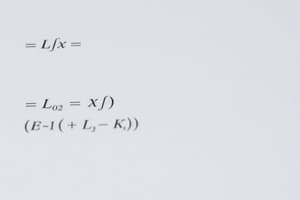Podcast
Questions and Answers
सीमा का प्रतिनिधित्व क्या है?
सीमा का प्रतिनिधित्व क्या है?
- एक फंक्शन के इनपुट के रूप में व्यवहार
- एक फंक्शन का डेरिवेटिव
- एक फंक्शन का व्यवहार एक विशिष्ट मान के पास आता है (correct)
- एक फंक्शन का मान
व्युत्पन्न का क्या प्रतिनिधित्व करता है?
व्युत्पन्न का क्या प्रतिनिधित्व करता है?
- एक फंक्शन का मान
- एक फंक्शन की दर से परिवर्तन (correct)
- एक फंक्शन का एकीकरण
- एक फंक्शन के इनपुट के रूप में व्यवहार
एक सीधी रेखा का समीकरण क्या है?
एक सीधी रेखा का समीकरण क्या है?
- ax / by = c
- ax + by = c (correct)
- ax + by + cz = d
- ax - by = c
एक बिंदु क्या है?
एक बिंदु क्या है?
एक कोण क्या है?
एक कोण क्या है?
एक वृत्त क्या है?
एक वृत्त क्या है?
एक पॉलिहेड्रॉन क्या है?
एक पॉलिहेड्रॉन क्या है?
एक एकीकरण क्या है?
एक एकीकरण क्या है?
लिमिट की संपत्ति क्या है?
लिमिट की संपत्ति क्या है?
Flashcards are hidden until you start studying
Study Notes
Calculus
Limits
- A limit represents the behavior of a function as the input (x) approaches a specific value
- Notation: lim x→a f(x) = L, read as "the limit as x approaches a of f(x) is L"
- Properties of limits:
- Linearity: lim x→a [af(x) + bg(x)] = a lim x→a f(x) + b lim x→a g(x)
- Homogeneity: lim x→a [f(x)g(x)] = [lim x→a f(x)][lim x→a g(x)]
Derivatives
- A derivative represents the rate of change of a function with respect to its input
- Notation: f'(x) or (d/dx)f(x), read as "the derivative of f with respect to x"
- Rules of differentiation:
- Power rule: if f(x) = x^n, then f'(x) = nx^(n-1)
- Product rule: if f(x) = u(x)v(x), then f'(x) = u'(x)v(x) + u(x)v'(x)
- Chain rule: if f(x) = g(h(x)), then f'(x) = g'(h(x)) * h'(x)
Integrals
- A definite integral represents the area under a curve between two points
- Notation: ∫[a, b] f(x) dx, read as "the integral from a to b of f with respect to x"
- Properties of integrals:
- Linearity: ∫[a, b] [af(x) + bg(x)] dx = a∫[a, b] f(x) dx + b∫[a, b] g(x) dx
- Additivity: ∫[a, c] f(x) dx = ∫[a, b] f(x) dx + ∫[b, c] f(x) dx
Geometry
Points, Lines, and Planes
- A point is a location in space, represented by an ordered pair (x, y) or triple (x, y, z)
- A line is a set of points extending infinitely in two directions, represented by the equation ax + by = c
- A plane is a flat surface, represented by the equation ax + by + cz = d
Angles and Measurements
- An angle is formed by two rays sharing a common endpoint (vertex)
- Angle measurements: degrees, radians, or revolutions
- Types of angles:
- Acute: < 90°
- Right: = 90°
- Obtuse: > 90° and < 180°
- Straight: = 180°
Shapes and Solids
- Types of shapes:
- Polygon: a closed shape with at least three sides (e.g., triangle, quadrilateral)
- Circle: a set of points equidistant from a central point (center)
- Types of solids:
- Polyhedron: a three-dimensional shape with flat faces (e.g., cube, pyramid)
- Sphere: a set of points equidistant from a central point (center)
कैलक्युलस
सीमा
- एक सीमा एक फंक्शन के व्यवहार का प्रतिनिधित्व करती है जैसे ही इनपुट (x) एक विशिष्ट मान की ओर बढ़ता है
- नोटेशन: lim x→a f(x) = L, "x के a मान की ओर बढ़ते हुए f(x) की सीमा L है"
- सीमा के गुण:
- रैखिक: lim x→a [af(x) + bg(x)] = a lim x→a f(x) + b lim x→a g(x)
- समता_homogeneity: lim x→a [f(x)g(x)] = [lim x→a f(x)][lim x→a g(x)]
अवकलज
- एक अवकलज एक फंक्शन के इनपुट के सापेक्ष दर का प्रतिनिधित्व करता है
- नोटेशन: f'(x) or (d/dx)f(x), "f का अवकलज x के सापेक्ष"
- अवकलन के नियम:
- शक्ति नियम: यदि f(x) = x^n, तो f'(x) = nx^(n-1)
- गुणन नियम: यदि f(x) = u(x)v(x), तो f'(x) = u'(x)v(x) + u(x)v'(x)
- श्रृंखला नियम: यदि f(x) = g(h(x)), तो f'(x) = g'(h(x)) * h'(x)
इंटीग्रल
- एक निश्चित इंटीग्रल एक कर्व के नीचे के क्षेत्रफल का प्रतिनिधित्व करता है
- नोटेशन: ∫[a, b] f(x) dx, "a से b तक f का इंटीग्रल x के सापेक्ष"
- इंटीग्रल के गुण:
- रैखिक: ∫[a, b] [af(x) + bg(x)] dx = a∫[a, b] f(x) dx + b∫[a, b] g(x) dx
- Additivity: ∫[a, c] f(x) dx = ∫[a, b] f(x) dx + ∫[b, c] f(x) dx
ज्यामिति
बिंदु, रेखाएं, और समतल
- एक बिंदु एक स्थान है, जिसका प्रतिनिधित्व एक क्रमित जोड़े (x, y) या त्रिविम क्रमित त्रिज्या (x, y, z) द्वारा किया जाता है
- एक रेखा दो दिशाओं में विस्तृत एक बिंदु सेट है, जिसका प्रतिनिधित्व एक समीकरण ax + by = c द्वारा किया जाता है
- एक समतल एक फ्लैट सतह है, जिसका प्रतिनिधित्व एक समीकरण ax + by + cz = d द्वारा किया जाता हा
कोण और माप
- एक कोण दो किरणों के मिलने से बनता है, जिसका निर्धारण एक बिंदु (शीर्ष) द्वारा किया जाता है
- कोण माप:
- डिग्री
- रेडियन
- क्रांति
- कोण के प्रकार:
- तीक्ष्ण: < 90°
- समरूप: = 90°
- लंब: > 90° और < 180°
- सीधा: = 180°
आकार और ठोस
- आकार के प्रकार:
- बहुभुज: एक करीब की आकृति जिसमें कम से कम तीन भुजा होती हैं (उदाहरण, त्रिभुज, चतुर्भुज)
- वृत्त: एक 集 के स्थान जो केंद्र से समान दूरी पर होता है
- ठोस के प्रकार:
- बहुफलक: एक त्रिविम आकृति जिसमें फ्लैट फेस होते हैं (उदाहरण, घन, पिरामिड)
- गोला: एक सेट के स्थान जो केंद्र से समान दूरी पर होता है
Studying That Suits You
Use AI to generate personalized quizzes and flashcards to suit your learning preferences.



